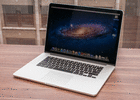With Google Chromebooks, price really does make all the difference.
For those unfamiliar with the term, Chromebooks are laptops running on Google's browser-based, cloud-focused Chrome OS. They're essentially laptops running a Web browser. That doesn't change with the newest Samsung Chromebook (model XE303C12), either.
Google's never really been all "Drop what you're using and switch to Chrome OS" about the whole thing, but with this machine it seems to be more up-front about positioning it as a good extra inexpensive computer that lies around the house and can be used for quickly, easily, and securely handling the Web needs of different users. Especially those who've come to rely less and less on traditional installed software.
 (Credit:
Sarah Tew/CNET)
(Credit:
Sarah Tew/CNET)
I find it a reasonable device for those categories, especially for people like myself who already have their heads in the Google cloud with Google Docs, Google Drive, and Gmail. It's got workable if not standout hardware, its battery life is good, it switches on quickly, and the $249 price tag means it's not as much of a commitment as the $450 (or $550 with 3G) Samsung Series 5 550 that arrived in May.
However, given its sluggish performance sometimes, I can't say I was blown away by the Samsung Chromebook. It's fine for many tasks, but power users accustomed to having more than a couple dozen browser tabs open should steer clear.
The big differences between Samsung's XE303C12 and earlier Chromebooks are that the XE303C12 is smaller, with a 11.6-inch screen; lighter and thinner; and very different under the hood. The Samsung Chromebook uses a low-power processor, Samsung's Exynos 5 Dual, which is built on ARM's new dual-core system-on-a-chip Cortex A15 design (prior versions used Intel Atom and Celeron processors). It also has just 2GB of system memory.
The design is very compact -- a bit narrower than Apple's 11-inch MacBook Air, but deeper and thicker. It's got a chiclet keyboard, a generously large touch pad, and a scalloped groove where you can use your thumb to flip up the screen. Samsung's battery life claims hold up, too (assuming you're not doing anything too terribly taxing).
Medium tweedium
The screen is OK, with pretty good resolution, adequate brightness, and a matte coating to cut down on glare. It's not terribly vivid, though, and doesn't have a very wide viewing angle. As Google claims, this Chromebook can play 1080p video, but the screen resolution is only 1,366x768 pixels, so it's not displaying full HD.
 (Credit:
Sarah Tew/CNET)
(Credit:
Sarah Tew/CNET)
In the same vein, the bottom-mounted speakers are workable but produce a muddy sound, especially when muted by fabric on your lap. In general, they're fine for casual use, but you're better off with headphones or external speakers.
Although the touch pad doesn't match Apple's (I haven't found one that does yet), it beats out many I've used recently, including some on laptops that are much more expensive. Google wisely adopted some Apple conventions with the touch pad, such as a two-finger tap to right-click and a two-finger swipe to scroll or pan. I find clicking requires too much pressure, but fortunately tapping will do the trick, too.
Those who want something as slim as the ultrabook era promises will be disappointed, in particular by the hinge that protrudes upward along the top when the system's lid is closed down. It's hardly chunky or heavy, though, measuring 0.7 inch thick and weighing in at 2.4 pounds. Frankly, I'm more concerned about light weight and fast wake-up times, and the Samsung Chromebook does well in those areas.
 (Credit:
Sarah Tew/CNET)
(Credit:
Sarah Tew/CNET)
The keyboard is adequate if you've gotten used to the chiclet era (I have). It's not a keyboard for pounders, though: the laptop's body flexes, and it makes a popping noise when I rest my rwrist on the face. And the keyboard isn't backlit.
Along the left edge of the laptop are an SD card slot and combination microphone-headphone jack. On the back are a USB 2.0 port, a USB 3.0 port (a first for a Chromebook), and an HDMI 1.4 port. A USB dongle for Ethernet is included if you can't or don't want to use the 802.11n Wi-Fi. A serviceable Webcam perches above the screen. Inside is 16GB of flash memory, but people with ordinary amounts of videos, music, photos, and letters will have to rely on Google Drive for some storage. Happily, Google gives Samsung Chromebook customers 100GB of space for two years.
 (Credit:
Sarah Tew/CNET)
(Credit:
Sarah Tew/CNET)
Chrome OS, of course
Hardware is only half the story here, though. The Chromebook is great for a $249 device, and it shows what an ARM-based system can do, but if you're not OK with Chrome OS, you should steer clear. Those who don't spend the bulk of their computing life in reach of Internet access -- wireless or wired -- should think twice, too.
Chrome OS, for the uninitiated, puts a version of Google's Chrome browser on top of a Linux foundation. Where Linux PCs run Linux apps, though, Chrome OS devices run browser apps. That's huge, since you can do more and more on the Web. But you can't run several popular programs -- iTunes, Skype, Portal 2, Microsoft Office, Photoshop, Spotify, or the Great Internet Mersenne Prime Search program, to name a few.
Aiming the Chromebook at people who want another device around the house, though, makes those shortcomings not necessarily be major drawbacks. There are plenty of times when all you need to do is check e-mail, read some news, load a recipe, make a bank payment, click around YouTube, or spend time on Facebook. For that, it's a very economical device. Its fast startup speed is conducive to flipping it open for a few moments and then plopping it down on the counter or coffee table again when you're done. (Its Wi-Fi is very fast to reconnect, too.)
















